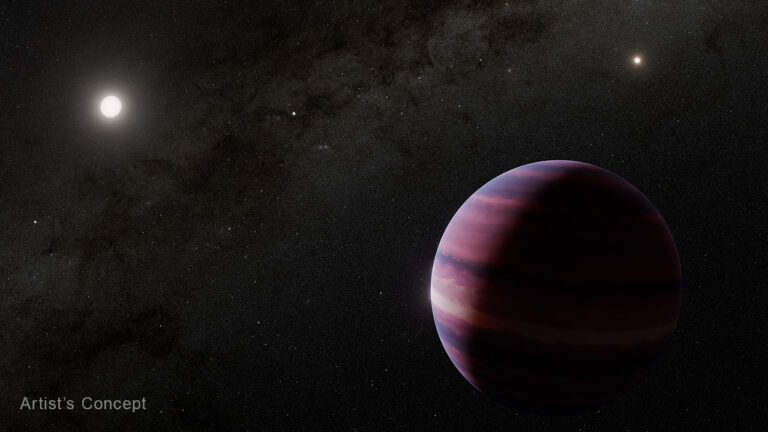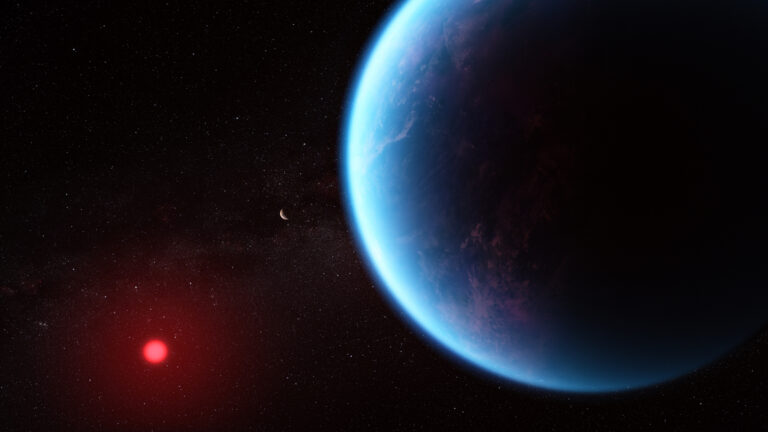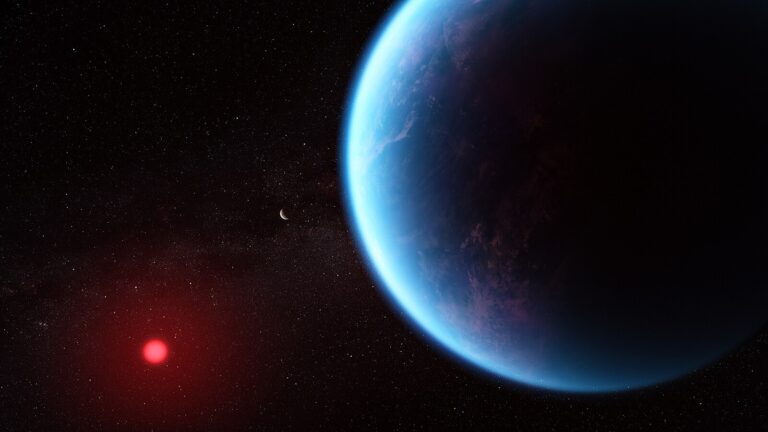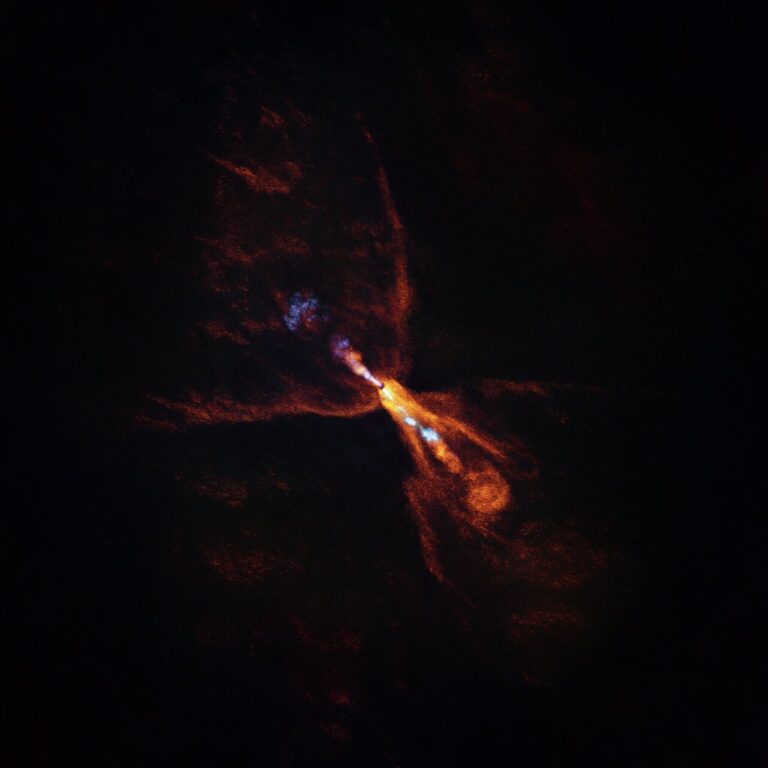Key Takeaways:
Astronomy articles— Steve Nadis explored magnetar bursts in “Neutron Stars with Attitude” in the March 1999 issue.
Related news stories — Most intense burst ever detected, Probing neutron stars
Web — NASA’s Gamma-ray-burst Coordinates Network published the amateur report of a Sudden Ionospheric Disturbance associated with SGR 1806-20. The American Association of Variable Star Observers set up a special web page to serve as a clearinghouse for information on the event.
Astronomy articles — Astronomers know of over 150 extrasolar planets, most of which were found by a team led by Geoff Marcy and Paul Butler. In March 2000, back when just 33 extrasolar planets were known, Marcy and Butler wrote “Hunting planets beyond.”
See also Robert Zimmerman’s (August 2004) “Seeking other Earths“; the full text is available to readers online here.
Related news stories — The first image of an exoplanet?, First exoplanet imaged, Pack extra sunscreen, Smallest exoplanet found
Astronomy articles — David Healy describes how you “Join the search for space rocks” in the March 2005 issue. In “Odd couples,” astronomer Dan Durda discusses why asteroids often come in pairs.
Related news stories — 2004 MN4: swing and a miss, Will Earth break up 2004 MN4?, The asteroid and the keyhole, Asteroid Apophis set for a makeover, Impact risk scale revised
Web — Former astronaut Rusty Schweickart introduced the idea of “tagging” Apophis with a transponder in a presentation to the International Space Development Conference last May; the text is available here.
For a summary of Apophis’ current impact risk, see this page on NASA’s Near Earth Object Program web site.
Related news stories — Shuttle’s next flight in March, Safe at home, NASA grounds shuttle fleet again, U.S. spaceport back in business, Shuttle launch to be determined, Panel: Shuttle safety still incomplete, Shuttle launch: not until July, Shuttle launch: May 22 at soonest, NASA’s new budget won’t fix Hubble
Web — For more on STS-114, Discovery’s return to flight, see NASA’s web page on the mission. The final report of the Stafford-Covey Return to Flight Task Group is available here.
Astronomy articles — In “An ice moon revealed,” (July 2005) senior editor Rich Talcott discusses Cassini’s first close look at Saturn’s moon Enceladus, including evidence pointing to an atmosphere. For an overview of the Cassini mission, see his “Cassini reaches Saturn” (October 2004).
Related news stories — Fascinating Phoebe, Cassini looks at the dark side, Saturn’s dynamic satellite, Saturn’s small but active moon, New moons for Saturn, Titan’s dynamic realm, Methane lake found on Titan?, Cassini reveals Titan
Web — Keep tabs on the Cassini mission by visiting the Cassini-Huygens web site.
Astronomy articles — Bruce Moomaw details Mars rover Spirit’s first investigations in “Spirit lands at Gusev” (April 2004). For full coverage of the rovers’ journeys, as well as much more, see Astronomy‘s special issue Mars: Explore the Red Planet’s past, present, and future.
Related news stories — One (Earth) year on the Red Planet, Reversal of fortune for Mars rovers, Opportunity: free at last, Spirit summits the Columbia Hills
Web — Track the Mars rovers at NASA’s Mars Exploration Rover web site and Cornell University’s Mission to Mars site.
Color and stereo images are also available from Michael Lyle’s Mars Exploration Rover Imagery page. Hans Nyberg has converted many of the rovers’ large panoramas into full-screen QuickTime Virtual Reality movies that allow you to pan around and zoom into the images.
Astronomy articles — Senior Editor Rich Talcott discusses early results from Deep Impact in “Blasting the past” (October 2005), while Alistair Ling’s preview of the mission, “Fireworks on the Fourth,” appeared in the June 2005 issue.
Related news stories — Getting set for Deep Impact, Deep Impact strikes its target
Web — Visit NASA’s Deep Impact web site as well as the University of Maryland’s site for more information, images, and videos of this unique experiment.
Astronomy articles — Raymond Shubinski’s “Hitch a ride on a cosmic spiral” (October 2005) delves into the history, folklore, and science of our galactic neighbor, M31.
Related news stories — Andromeda’s vast starry disk, Andromeda times three, Super-sized galaxy, First direct distance to Andromeda
Web — See Scott Chapman’s home page for more on M31’s giant disk. This release by the Gemini Observatory provides images and links related to NGC 300’s extended disk.
Astronomy articles — Francis Reddy’s article by the same name in the November 2005 issue discusses what astronomers knew about Xena before they found its moon, and what its discovery means for Pluto.
Related news stories — Tenth planet discovered, The “tenth planet” gets a sidekick
Web — Keep updated on Xena, Gabrielle, and the other Kuiper-belt objects Caltech’s Michael Brown is finding by visiting his web site.
Astronomy articles — Read Senior Editor Rich Talcott’s summary of the Huygens landing in “The touchdown” (April 2005).
Related news stories — A windy day on Titan, Huygens lands on Titan, Huygens heads for Titan
Books — The Legacy of J. C. Kapteyn, edited by P. C. van der Kruit and K. van Berkel (Kluwer Academic Publishers, Dordrecht, the Netherlands, 2000) contains numerous articles about Kapteyn’s life, work, and influence.
The Alchemy of the Heavens by Ken Croswell
(Doubleday/Anchor, New York, 1995) describes how the Kapteyn
universe fit into our understanding of the Milky Way Galaxy.
Astronomy articles — Julius Benton, Jr., who directs the Saturn section of the Association of Lunar and Planetary Observers (ALPO) provided a wealth of information on observing the planet in “Saturn in prime time” (January 2004).
Web — Check out the Saturn observation pages of ALPO and the British Astronomical Association.
The Cassini-Huygens mission to Saturn sponsors a Saturn Observation Campaign each year as a public-outreach effort. You must apply to join the team, which consists mostly of amateur astronomers. Members conduct star parties in their local communities and provide talks to community groups about the Cassini mission. During 2005, members held 800 events reaching over 80,000 people. Owning a telescope is not a requirement, but having access to telescopes through local astronomy clubs or science centers is.
According to Jane Houston Jones, the site’s curator, the campaign is now looking for new members. The campaign’s web site will be updated with information for the 2006 observing season in mid-December 2005.









